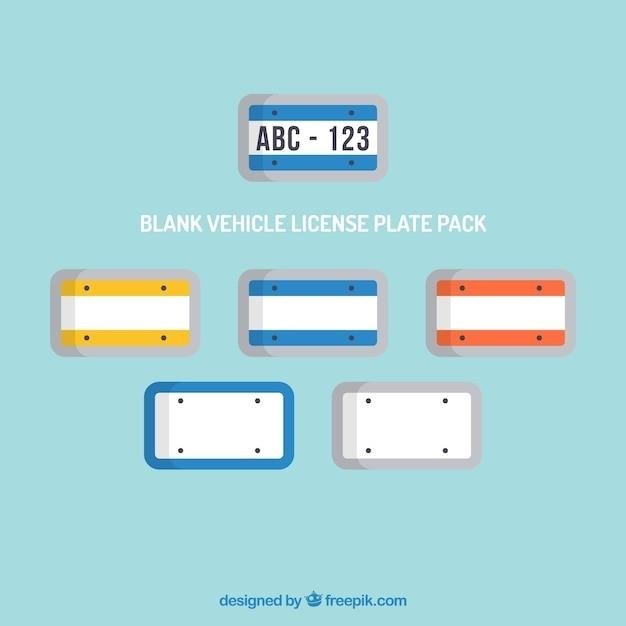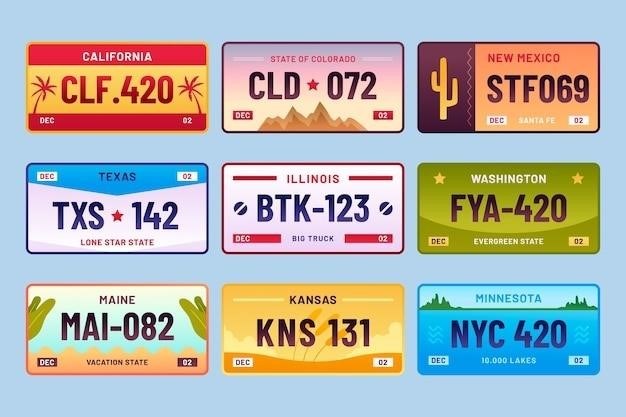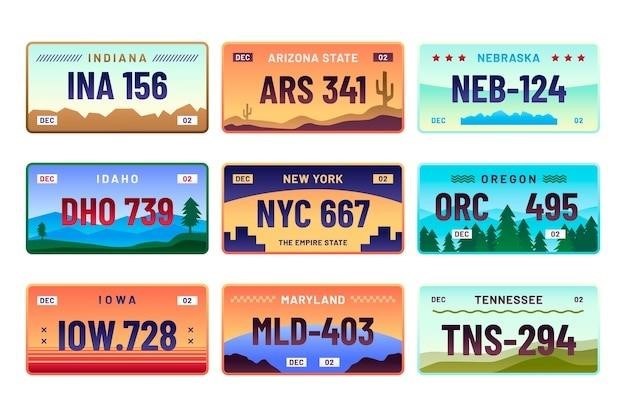License Plate Game⁚ A Printable PDF Guide
This guide provides a step-by-step process for creating a fun and engaging license plate game‚ complete with a printable PDF template. Download‚ customize‚ and enjoy!
The License Plate Game is a classic travel pastime‚ perfect for long car journeys or even short trips around town. The basic premise is simple⁚ players spot license plates from different states‚ provinces‚ or countries‚ marking them off on a score sheet. The first person to spot a predetermined number of unique plates wins! This printable PDF guide will help you create your own customized version of this game‚ enhancing the experience for players of all ages. Forget relying on scraps of paper; this guide empowers you to create a professional-looking‚ reusable game sheet. You’ll learn how to design a visually appealing and functional document‚ incorporating elements that encourage participation and friendly competition. Whether you’re planning a family road trip‚ a school field trip‚ or simply want a fun activity for a car ride‚ this printable PDF offers a convenient and engaging solution. This guide will walk you through the process‚ from initial design to printing and lamination‚ ensuring your game is ready for countless hours of fun on the road.
Variations of the License Plate Game

Beyond the basic license plate spotting game‚ numerous variations exist to increase the challenge and fun. Consider adding a thematic element‚ focusing on specific state or country plates‚ perhaps those with unique designs or historical significance. For a more complex game‚ assign point values to different plates‚ awarding more points for rarer or more distant locations. Incorporate letter or number challenges; for instance‚ players might need to find plates with specific letters or number combinations. Teamwork can be introduced by dividing players into groups‚ each competing to collect the most points. Introduce a time limit to add pressure and excitement‚ encouraging quicker observation skills. To engage younger players‚ simplify the game by focusing on a smaller geographic area or using easily identifiable features on the plates. For older players‚ create a more sophisticated version‚ incorporating geographical puzzles or trivia related to the license plates spotted. These variations ensure that the game remains engaging and adaptable to different age groups and preferences‚ keeping the fun alive throughout the journey. Remember to tailor the complexity to your players’ abilities and preferences for optimal enjoyment.
Preparing Your Printable PDF
Before designing your license plate game sheet‚ gather your necessary tools. You’ll need a word processing program or a dedicated design software like Adobe InDesign or Canva‚ capable of creating and exporting PDF files. Decide on the size and orientation of your game sheet; a standard letter size (8.5×11 inches) is often convenient. Consider the number of players and the amount of space needed for recording information. If you plan on laminating the sheet‚ account for potential shrinkage or expansion during the lamination process. Choose fonts that are easy to read‚ especially for younger players. Select a clear and visually appealing layout; think about how you want to organize the spaces for recording license plate information‚ points‚ and any other game elements. Remember to include clear instructions on how to play the game. If adding images or graphics‚ ensure they are high-resolution to avoid pixelation when printed. Pre-test your design by printing a draft copy to check for any layout issues or readability problems before finalizing the PDF for printing and distribution.
Designing Your License Plate Game Sheet
Now‚ let’s design your printable license plate game sheet! Start by creating sections for recording license plate information. You might use boxes or tables‚ ensuring enough space for license plate numbers and letters. Consider adding columns for tracking points or other scoring metrics. If you’re incorporating different categories (e.g.‚ states‚ vehicle types)‚ design separate areas for recording each category. To enhance visual appeal‚ use borders‚ lines‚ or shading to clearly delineate these sections. Remember to include a header clearly stating the name of the game and any essential instructions. Use a font size and style that’s easily legible‚ especially for children. If your design includes images or graphics‚ place them strategically to avoid cluttering the sheet. Ensure there’s ample white space to prevent a cramped or overwhelming look. Think about color schemes that are engaging but not distracting. Test the layout by printing a sample to check for any spacing or readability issues before creating the final version. You might consider adding a space for players’ names at the top of the sheet.
Adding Engaging Elements to Your PDF
To make your license plate game PDF truly captivating‚ consider incorporating engaging elements beyond the basic data recording sections. Think about adding colorful illustrations or themed graphics related to cars‚ travel‚ or road trips. These visuals can significantly enhance the game’s appeal‚ especially for younger players; You could also include a small map of the United States or a world map if your game involves tracking license plates from different regions. Adding small‚ fun illustrations next to each state or region can add extra interest for kids. Consider using different fonts for headers‚ instructions‚ and data entry fields to create visual distinction and improved readability. Incorporate playful icons or symbols to represent specific categories or achievements within the game. If you’re adept at graphic design‚ you might even create custom characters or mascots that fit the theme of your license plate game. Remember that the goal is to create a visually stimulating and enjoyable experience without overwhelming the sheet with too many elements. Always prioritize clarity and functionality.
Creating a Scoring System
A well-designed scoring system is crucial for adding an extra layer of fun and competition to your license plate game. Consider different scoring methods to suit your players’ ages and preferences. A simple point system‚ where each unique state or province spotted earns a certain number of points‚ is easy to understand and implement. For added complexity‚ you could award bonus points for spotting rarer license plates or those from distant locations. A tiered system‚ with escalating point values for increasingly challenging finds‚ could also add excitement. To make the scoring more engaging‚ incorporate a visual element such as a progress bar or a chart to track points earned. This visual representation will allow players to see their progress and stay motivated. You might even include space for players to draw or color in elements as they earn points‚ making the game more interactive‚ especially for younger participants. Remember to clearly explain the scoring system on your PDF‚ using simple language and possibly visual cues to avoid any confusion during gameplay. Clearly define how points are awarded and how the winner is determined to ensure fair play and avoid disputes. Ultimately‚ the best scoring system will be one that enhances the fun and competitiveness of the game without making it overly complicated.
Tips for a Fun and Engaging Game
To maximize enjoyment‚ consider incorporating elements beyond simple license plate spotting. Introduce themed challenges‚ such as finding a specific type of vehicle with a particular state plate‚ or looking for plates with certain numbers or letters. This adds a layer of strategic thinking and excitement. For younger players‚ focus on simpler challenges and shorter game durations‚ allowing for breaks and maintaining their interest. Older players might enjoy more complex challenges and longer game times‚ fostering a greater sense of accomplishment. Using timers can add an element of urgency and make the game more dynamic. Remember to adjust the difficulty based on the age and experience of the players; a game that’s too easy can be boring‚ while one that’s too hard can be frustrating. Incorporate prizes or rewards to further incentivize participation and engagement; small tokens‚ stickers‚ or even bragging rights can significantly increase the fun factor. Encourage teamwork and collaboration by allowing players to work together to achieve common goals‚ transforming the game into a cooperative experience. Most importantly‚ adapt the game to suit the specific context and preferences of the players‚ making it a truly personalized and enjoyable experience for everyone involved.
Printing and Laminating Your PDF
Once your meticulously designed license plate game PDF is ready‚ printing it correctly is crucial for optimal gameplay. Choose a high-quality printer capable of producing vibrant colors and sharp images to ensure the game sheet is visually appealing and easy to read. Select the appropriate paper type; heavier weight paper (at least 80lb) will enhance durability and prevent tearing‚ especially if you plan on frequent use. Before printing multiple copies‚ test print a single sheet to verify the colors‚ alignment‚ and overall quality. Adjust printer settings as needed to optimize output. After printing‚ laminating your game sheet is highly recommended to increase its lifespan and protect it from wear and tear‚ spills‚ and accidental damage. Use a home laminator or take it to a local print shop for professional laminating. Ensure the laminating process is smooth and free from bubbles to prevent any issues with readability or gameplay. Proper lamination will transform your game sheet into a durable‚ long-lasting‚ and reusable asset‚ perfect for numerous rounds of exciting license plate spotting.
Troubleshooting Common Issues

Encountering problems with your printable license plate game PDF? Don’t worry‚ common issues often have simple solutions. If your printed sheet appears blurry or faded‚ check your printer settings and ensure you’re using high-quality ink and paper. A test print can help identify potential printer malfunctions. If the colors are not vibrant enough‚ adjust the color saturation settings in your PDF editor before reprinting. Are the game elements too small or difficult to read? Increase the font size or adjust the spacing within your design software before generating the final PDF. If the PDF file itself is corrupt or unreadable‚ try downloading it again or using a different PDF viewer. Experiencing issues with laminating? Ensure your laminator is correctly calibrated and functioning correctly. Air bubbles trapped under the laminate can usually be smoothed out with gentle pressure. If the laminate is peeling or wrinkling‚ use a higher-quality laminate film. Remember to always test print and laminate a single sheet initially to identify and resolve any potential problems before committing to a full print run. By addressing these common issues proactively‚ you can ensure a smooth and successful game-making experience.
Using the Game with Children
The license plate game offers a fantastic opportunity to engage children in a fun and educational activity. Before starting‚ explain the rules clearly and simply‚ tailoring the complexity to their age and understanding. For younger children‚ focus on identifying letters and numbers‚ making the game a playful learning experience. Older children can be challenged to identify specific license plate features or create more complex scoring systems. Make the game collaborative‚ encouraging teamwork and friendly competition. Consider offering small prizes or rewards to incentivize participation and enhance the excitement. Supervise younger children closely‚ ensuring safe handling of the game materials. Adjust the game duration based on their attention span‚ keeping the sessions short and engaging to maintain interest. Incorporate storytelling elements‚ creating narratives around the license plates spotted‚ to add a creative and imaginative dimension. Adapt the rules or introduce variations to keep the game fresh and exciting. Remember to focus on having fun and making it a positive learning experience. By adapting the game to suit their age and interests‚ you can turn the license plate game into a memorable and educational adventure for the entire family.
Adapting the Game for Different Ages
The beauty of the license plate game lies in its adaptability across different age groups. For preschoolers‚ simplify the game by focusing on identifying individual letters or numbers on the license plates. Use large‚ colorful printable sheets and make the scoring system very basic‚ rewarding them for simply spotting a letter or number. Young children can also benefit from focusing on colors‚ shapes‚ and simple patterns on the plates. Elementary school children can be introduced to more complex challenges‚ such as identifying specific letter combinations or number sequences. They can also be involved in creating their own scoring system or adding extra rules to the game. Teenagers and adults can enjoy more advanced versions‚ involving specific state license plates‚ identifying rare characters‚ or creating complex scoring systems based on various factors. Consider adding a time limit to enhance the challenge for older players. Remember to adjust the difficulty and complexity of the game to match the age and cognitive abilities of the players. The goal is to make it fun and engaging for everyone‚ regardless of their age. Encourage creativity and collaboration by allowing players to design their own rules and variations of the game.
Beyond the Basic Game⁚ Advanced Variations
Once you’ve mastered the basics‚ elevate your license plate game with exciting advanced variations! Introduce thematic challenges‚ such as spotting license plates from specific states or countries‚ adding a geographical element to the game; Create a points system that rewards rarer license plate combinations or specific number sequences‚ making the game more strategic and competitive. Consider incorporating a time limit to increase the pressure and excitement‚ demanding quicker observation skills; For a truly challenging twist‚ try a photo scavenger hunt where players must locate and photograph specific license plates‚ adding a photographic component to the game. Another engaging variation could involve creating a story or narrative based on the letters and numbers spotted on the license plates‚ prompting creative storytelling abilities. Team-based gameplay can also add a collaborative dimension‚ requiring players to work together to achieve a common goal. You can even integrate technology by creating a digital version of the game‚ using apps or websites to track scores and add interactive elements. Remember to adjust the difficulty and complexity of these advanced variations to suit the players’ skills and experience levels. The possibilities are endless!
